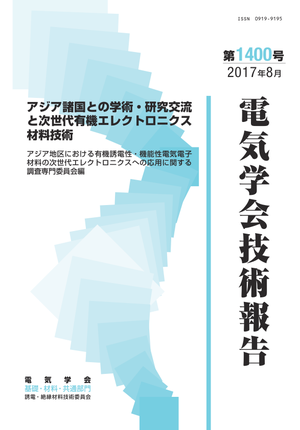アジア諸国との学術・研究交流と次世代有機エレクトロニクス材料技術
アジア諸国との学術・研究交流と次世代有機エレクトロニクス材料技術
カテゴリ: 技術報告
論文No: 1400
グループ名: 【A】基礎・材料・共通部門
発行日: 2017/08/30
タイトル(英語): Academic and Research Exchange with Asian Countries, and Next-generation Electronic Materials Technology
著者名: アジア地区における有機誘電性・機能性電気電子材料の次世代エレクトロニクスへの応用に関する調査専門委員会
著者名(英語): Investigating R&D Committee on Application to the Next-generation Electronics of the Study of Organic Dielectricity and Functionality of Electrical and Electronic Materials in the District of Asia
キーワード: アジア諸国, 研究交流, 有機機能性材料, 有機分子素子工学, 次世代エレクトロニクス/Asian countries, Research exchange, Organic functional materials, Engineering of organic molecular devices, Next-generation electronics
要約(日本語): 21世紀の科学技術の重点分野として, 環境・エネルギー・ライフサイエンス・バイオ・通信・ナノテクノロジーがあげられ, 有機誘電体・半導体材料や有機分子素子の役割の重要性が指摘されている。このような重点分野は学際的かつ国際的な連携で研究が急ピッチで進むと考えられているため, 欧米は勿論のこと, 台頭著しいアジア諸国の科学技術の動向を的確に把握する必要がある。このような背景から, 本委員会では, 韓国, 中国, インドを中心とするアジア諸国における有機誘電性・機能性電気電子材料, すなわち有機誘電体・半導体・導電体・機能性材料や有機分子素子で構成される構造体の持つ性質と特徴の趨勢と次世代エレクトロニクスへの応用に関し, その地域に特有な文化も踏まえて研究動向の調査活動をすすめてきた。さらに, 有機誘電体・半導体・導電体材料や有機分子素子材料の持つ性質と特徴を電気電子工学分野で活用するために必要となる工学体系として「有機分子素子工学」への展開を図ることをその目的とした。 現在、有機エレクトロニクス研究は, 安価で柔軟な電子デバイスを基盤とする新しい工学技術であり, シリコンをはじめとする無機半導体を中心に発展してきたエレクトロニクスの世界が大きく変わろうとしている。 本技術報告書は, 以下に示す項目で構成されている。
総論
第I編 アジア諸国との学術・研究交流
1章 中国・韓国との交流を中心として
2章 インドの社会環境と科学政策
3章 タイとの交流
第II編 次世代有機エレクトロニクス材料技術の研究動向
1章 有機薄膜作製技術とシミュレーションによる評価の試み
2章 有機電気電子材料中の電荷計測技術
3章 プリンテッド薄膜トランジスタ技術
4章 機能性液体の光学応用
5章 生体イオントロニクス
まとめ
本技術報告書は, 有機誘電体・導電性電気電子材料研究のアジア諸国の動向を把握するうえで, 関連領域の技術者・研究者に必読の書である。
要約(英語): In electrical engineering and electronics of the 21st century, it has been believed that the role of organic molecular materials is extremely important, in addition to organic dielectrics and semiconductor materials. It is necessary to comprehend precisely the research trend of the growing Asian countries, not to mention advanced Europe and America, and of the studies progress under the interdisciplinary and international cooperation. Upon paying attention to the culture peculiar to the location, we have investigated and discussed the characteristics of the study based on application to the next-generation electronics of organic dielectrics, conductive electrical and electronic materials in Asian countries such as China, Korea, India etc. Furthermore, to make use well of properties and characteristics of organic dielectrics, semiconductors, conductive materials and organic molecular devices in the field of electrical and electronic engineering, we have been investigating research activities worldwide. The objective our investigation was to establish new scholarly engineering which is necessary for organic electronics, and “engineering of organic molecular devices” is our goal. The field of organic electronics promises exciting new technologies based on inexpensive and mechanically flexible electronic devices and the world of electronics which have been developed mainly on a silicone semiconductor is going to change drastically. This technical report is comprised of all eight chapters by the following item.
Introduction
Part I : The academic and research exchange with Asian countries
Chapter 1. Academic and research exchange with China, Korea, and other countries
Chapter 2. Social environment and scientific policy in India
Chapter 3. Exchange with Thailand
Part 2 : Research trend of the next-generation organic electronic materials technology
Chapter 1. Fabrication techniques of organic thin films and the evaluation based on simulation
Chapter 2. Measurement techniques for studying charge behavior in organic electrical and electronic materials
Chapter 3. Printed thin-film transistor technologies
Chapter 4. Optical applications of functional liquids
Chapter 5. Bioiontronics
Summary
We hope this technical report can further the field, and provide a reference for and insights into organic electronic, photonic, and iontronic materials and devices.
PDFファイルサイズ: 19,462 Kバイト
受取状況を読み込めませんでした




